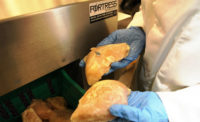Food Safety
Is your facility food safe and defensible?
With FSMA a done deal for food & beverage processors, compliance is more important than ever

Unless your facility is a USDA shop, then it most likely falls under FSMA regulations, which for the vast majority of processors is the law of the land. If you haven’t yet been visited by FDA for an audit, it is past time to get ready for that inevitable moment. I asked Ib Elandaloussi (CAL), Food and Consumer Products Group with Burns and McDonnell to talk briefly about designing facility solutions to meet FSMA rules.
Elandaloussi specializes in food safety at Burns & McDonnell, including developing and implementing complete food safety systems for food manufacturers. His experience includes not only determining areas of non-conformance, but also prioritizing and designing cost-effective solutions for clients to become FSMA compliant.
“Food safety and security are among the highest priority considerations throughout the industry so it is common to have professionals experienced in safety and security be involved early in the design phase for retrofits and greenfield projects,” says Elandaloussi. “It is the best way to see that good safety principles are designed into the infrastructure.”
FE: How should a facility be designed to support GMPs?
Elandaloussi: It is imperative that a facility be designed to meet Good Manufacturing Processes (GMPs). This will entail controlling movements of personnel and materials to minimize cost escalation and will also address air flows and HVAC systems to minimize the risk of cross contamination. A good design will specify the right air filters for a particular application. Humidity controls will be addressed as well—a very important consideration, particularly in the Midwest and most of the South. Facility operators must be aware that some humidity can be introduced through wash-down processes so humidity controls will be needed in cold areas. Also important: Equipment design and equipment specs must be properly reviewed to make sure all equipment can be thoroughly cleaned and will not harbor points for microorganisms to grow.
Allergens are another important consideration, and facilities must be designed to segregate allergen and non-allergen materials. You will want physical segregation of the areas where materials that contain known allergens will be stored.
FE: I’ve been in older plants where it seems physical security could use some improvement. What can plants do to beef up this area?
Elandaloussi: Physical security cannot be overlooked. Processors should be aware that many recent instances of food recalls can be traced to incidents involving disgruntled employees working on-site. Employees who are dismissed for any reason must not have access to the site after termination. Employees are often the first line of defense and should be trained to be on the lookout for someone trying to get back into the plant, and that this is usually not a random occurrence. Security isn’t just about keeping strangers out. Plans and processes need to account for the potential of incidents involving a previous employee because this has proven to be a high-risk area.
The Food and Drug Administration has put together requirements as part of the Food Defense Plan, which is free to access and very holistic for identifying risks and potential consequences. This includes different areas of defense, including having the right security systems at the plant. This includes a badging system for employees who need access, proper fencing and the setting up of guard shacks. Even with people coming to the plant for legitimate reasons, it is important to protect against the possibility they could be potentially bringing pathogens with them. A detailed training program for visitors will outline the steps to prevent these occurrences.
Visitors and employees must abide by all GMP rules and have proper knowledge of personal hygiene procedures. Security cameras should be operating at all entrances, and doors at all outside entrances should automatically close. Employee breakrooms should be located outside of production areas to provide tighter controls.
The overall site must have fencing for proper security controls. Employees must be properly trained to be aware of potential threats when visitors gain access without being properly identified at the security gates, and a visitor alert system must be easily accessible when an employee identifies someone inside the building and needs to notify the floor supervisor. Finally, do not underestimate the importance of regular training. It is natural for people to become complacent, so continual reminders of processes and procedures are a must.
For more information on food safety and defense:
“10 Steps to Developing a Dedicated Food Safety Plan,” Ib Elandaloussi, PCQI, Burns & Mc Donnell, PDF.
“White Paper: Protecting Food Quality Through Physical Security,” Kevin Whaley, Burns & Mc Donnell, PDF.
Burns & McDonnell: www.burnsmcd.com
Looking for a reprint of this article?
From high-res PDFs to custom plaques, order your copy today!






